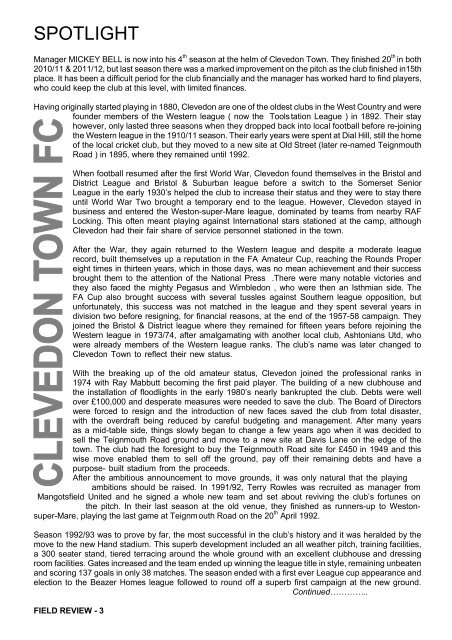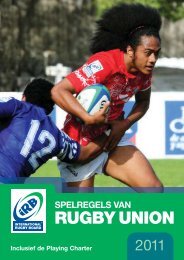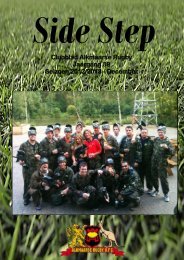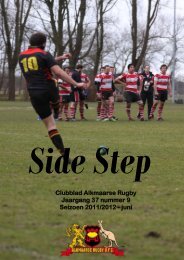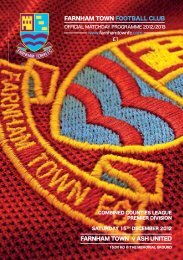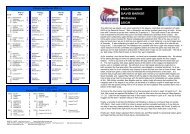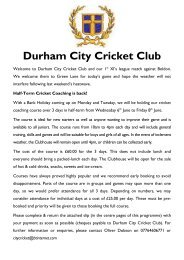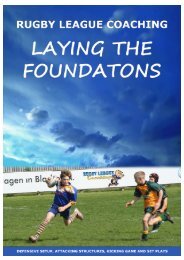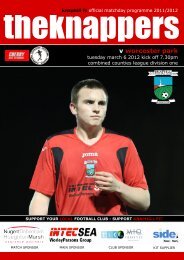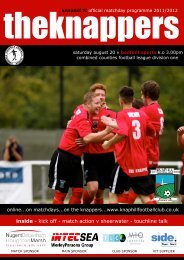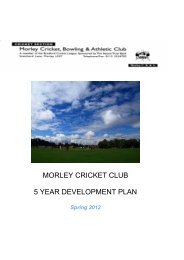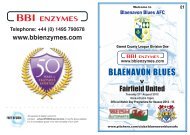Mangotsfield United FC - Pitchero
Mangotsfield United FC - Pitchero
Mangotsfield United FC - Pitchero
Create successful ePaper yourself
Turn your PDF publications into a flip-book with our unique Google optimized e-Paper software.
SPOTLIGHTManager MICKEY BELL is now into his 4 th season at the helm of Clevedon Town. They finished 20 th in both2010/11 & 2011/12, but last season there was a marked improvement on the pitch as the club finished in15thplace. It has been a difficult period for the club financially and the manager has worked hard to find players,who could keep the club at this level, with limited finances.Having originally started playing in 1880, Clevedon are one of the oldest clubs in the West Country and werefounder members of the Western league ( now the Toolstation League ) in 1892. Their stayhowever, only lasted three seasons when they dropped back into local football before re-joiningthe Western league in the 1910/11 season. Their early years were spent at Dial Hill, still the homeof the local cricket club, but they moved to a new site at Old Street (later re-named TeignmouthRoad ) in 1895, where they remained until 1992.When football resumed after the first World War, Clevedon found themselves in the Bristol andDistrict League and Bristol & Suburban league before a switch to the Somerset SeniorLeague in the early 1930’s helped the club to increase their status and they were to stay thereuntil World War Two brought a temporary end to the league. However, Clevedon stayed inbusiness and entered the Weston-super-Mare league, dominated by teams from nearby RAFLocking. This often meant playing against International stars stationed at the camp, althoughClevedon had their fair share of service personnel stationed in the town.After the War, they again returned to the Western league and despite a moderate leaguerecord, built themselves up a reputation in the FA Amateur Cup, reaching the Rounds Propereight times in thirteen years, which in those days, was no mean achievement and their successbrought them to the attention of the National Press .There were many notable victories andthey also faced the mighty Pegasus and Wimbledon , who were then an Isthmian side. TheFA Cup also brought success with several tussles against Southern league opposition, butunfortunately, this success was not matched in the league and they spent several years indivision two before resigning, for financial reasons, at the end of the 1957-58 campaign. Theyjoined the Bristol & District league where they remained for fifteen years before rejoining theWestern league in 1973/74, after amalgamating with another local club, Ashtonians Utd, whowere already members of the Western league ranks. The club’s name was later changed toClevedon Town to reflect their new status.With the breaking up of the old amateur status, Clevedon joined the professional ranks in1974 with Ray Mabbutt becoming the first paid player. The building of a new clubhouse andthe installation of floodlights in the early 1980’s nearly bankrupted the club. Debts were wellover £100,000 and desperate measures were needed to save the club. The Board of Directorswere forced to resign and the introduction of new faces saved the club from total disaster,with the overdraft being reduced by careful budgeting and management. After many yearsas a mid-table side, things slowly began to change a few years ago when it was decided tosell the Teignmouth Road ground and move to a new site at Davis Lane on the edge of thetown. The club had the foresight to buy the Teignmouth Road site for £450 in 1949 and thiswise move enabled them to sell off the ground, pay off their remaining debts and have apurpose- built stadium from the proceeds.After the ambitious announcement to move grounds, it was only natural that the playingambitions should be raised. In 1991/92, Terry Rowles was recruited as manager from<strong>Mangotsfield</strong> <strong>United</strong> and he signed a whole new team and set about reviving the club’s fortunes onthe pitch. In their last season at the old venue, they finished as runners-up to Westonsuper-Mare,playing the last game at Teignmouth Road on the 20 th April 1992.Season 1992/93 was to prove by far, the most successful in the club’s history and it was heralded by themove to the new Hand stadium. This superb development included an all weather pitch, training facilities,a 300 seater stand, tiered terracing around the whole ground with an excellent clubhouse and dressingroom facilities. Gates increased and the team ended up winning the league title in style, remaining unbeatenand scoring 137 goals in only 38 matches. The season ended with a first ever League cup appearance andelection to the Beazer Homes league followed to round off a superb first campaign at the new ground.Continued…………..FIELD REVIEW - 3


